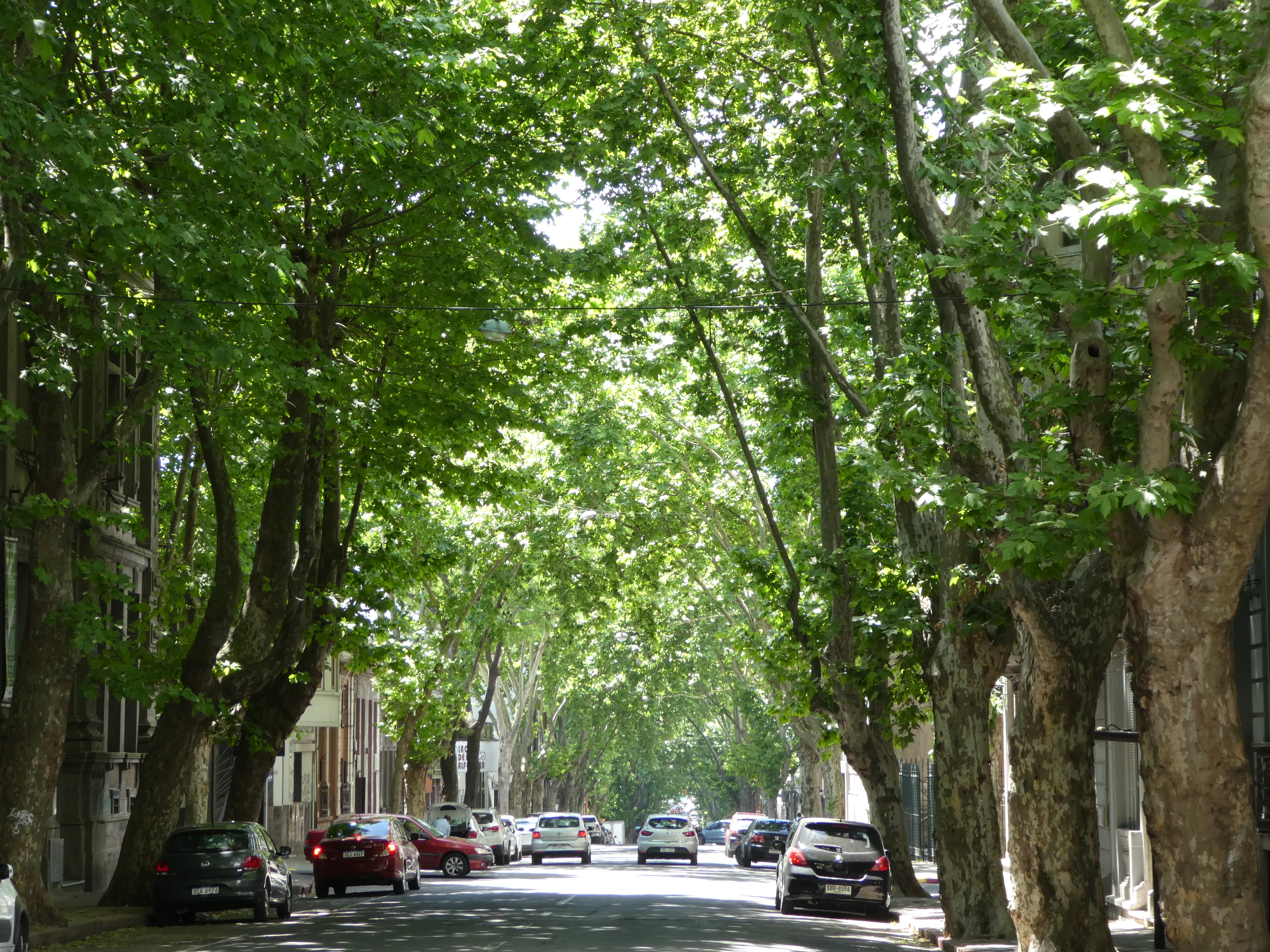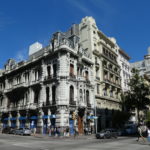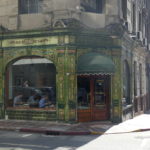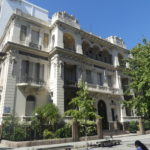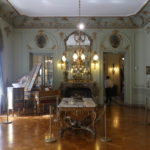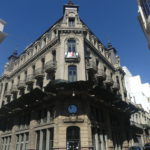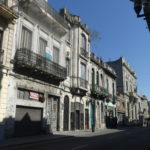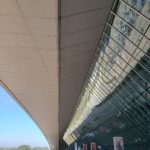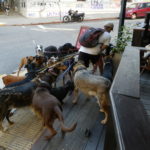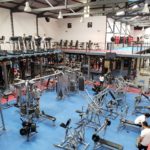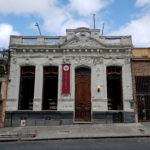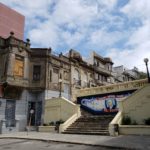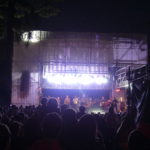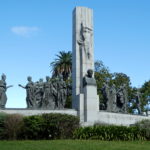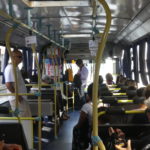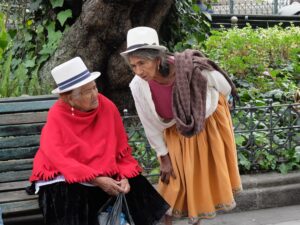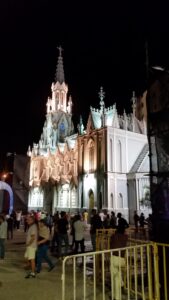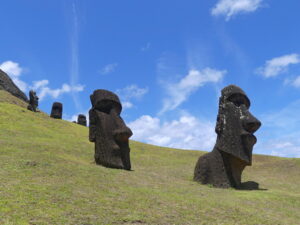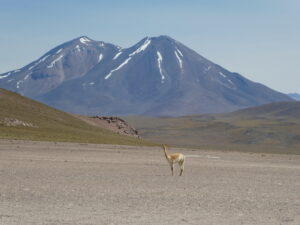Near the end of our six month stay in Uruguay’s capital, we revisited the old (and relatively) new downtown to see what we might have missed and also looked back at some of our neighborhood’s charms.
THE CITY
Walking again along the streets of central Montevideo, we found a lot to gawk at. Many buildings in a 19th century Eclectic style (a bit of baroque and a bit of whatever) intermingle with Art Deco and later modernist buildings. In the main commercial district, even the most ornate buildings are likely to have shops on their ground floor, offering high end goods over here or low end goods there. But you can’t just stare upward in admiration; you have to watch your step. The streets are bustling all the time with shoppers and office workers. The city has stayed very lively.
Here is a typical corner on the high street of Montevideo, 18th of July, the central shopping district. So many different styles in one place.
Beautiful tiling makes this cafeteria especially inviting, while nearby stand some intriguing art deco buildings.
The elegant mansion of the Supreme Court on a quiet pedestrian street of governmental buildings.
Once a wealthy family home, this salon is now part of the Museum of Decorative Arts in the old town. Many other mansions nearby are also museums. At the back left of the salon, that’s a late 19th century reproduction by Pleyel of a classical period piano. Do not touch, the sign warns.
19th century bank building in the old town.
Typical city street in the old town, something old and something new in various states of upkeep.
The 25 kilometer long beachfront of the city can also be pretty busy at times, especially close to town.

This is a tranquil promontory about halfway along the shore and one of the many spots you can find that take you away from the bustle. In the distance, you can see downtown still.
By contrast, and far outside the central city, the new arc-like airport is still restful and quiet, as well as elegant in design. Though the displays boards showed plenty of flights, the place never seemed crowded.
THE NEIGHBORHOOD
We were especially sad to leave all those familiar things and people we had come to cherish – whether our favorite watering hole and regular waiter, our kindly produce vendors at the Wednesday street market, the staff at our Club One gym and the familiar equipment, our local hairdresser, the friends we made… Here are some of the memories we’ll carry with us. Ciao, Montevideo!
So many of the local streets were shaded from the sun by the huge trees along the sidewalks, making for glorious allees.
We posted how dogs seemed to have a good life in Montevideo, with many vets to cater to them. Most dogs did not need to be on leash to stay with their owners, even at street crossings. And then there were the talented dog-walkers tending a host of pets at once. Here is our neighborhood favorite among these, stopped to untangle things just outside our favorite eatery.
The multi-levels of Club One gym, which served us well, even though it could be a bit busy at times and quite hot in summer days, as it lacked air conditioning – except mercifully in the changing rooms. That’s Nancy on the back left working the treadmill.
A national heritage building on our street, fancy but well integrated with the others.
Many walls show the work of graffiti artists, with varying artistry, but some of the paintings seemed commissioned to grace the life of passers-by.
A quirky change of levels on a street just a few blocks away from us and the shoreline.
Our apartment enjoyed a lovely panorama of Parque Rodo, our huge neighborhood park. Sunset often made the stream glow as it flowed from the park’s pond. On the pond, we would see paddle boats, as well as a small fort on its banks. The park was a magnet for locals. They would loll and play during weekends and evenings – generally carrying the somewhat requisite tools for mate, a kind of tea – a cup with a silver stirrer and a thermos to replenish it. On Sundays, a large, busy goods market drew people from around the city.
Entertainment of various sorts was frequent in Parque Rodo – often impromptu like the groups playing the tambores, drums used in candombe music, or at times organized by the city as free concerts. Here is a photo from one we attended at their temporary stage. Top local groups like the widely known reggae band Abuela Coca would often perform. And there was always something else to see and do, such as karate or exercise classes, or pickup jazz groups, or photographic displays.
We have admired the sculptural work of Jose Belloni. But only near the end of our stay did we discover his work at a corner of the park honoring the writer for whom our park was named, Jose Enrique Rodo.
Montevideo has no metro, but we didn’t need a car at all. The bus system is a marvel, with so many overlapping routes, and an interactive online guide that showed you the dozens of way to go from our home to anywhere in the city. A dozen lines or more stopped around Parque Rodo. And all for about $1.50 USD for a trip of 2 hours, and less for just one hour. The diesel powered buses were plain and simple, though way too noisy when starting up or climbing. Yet we relied on them – as did other city residents.
(Also, for more pictures from Uruguay, CLICK HERE to view the slideshow at the end of the itinerary page.)


